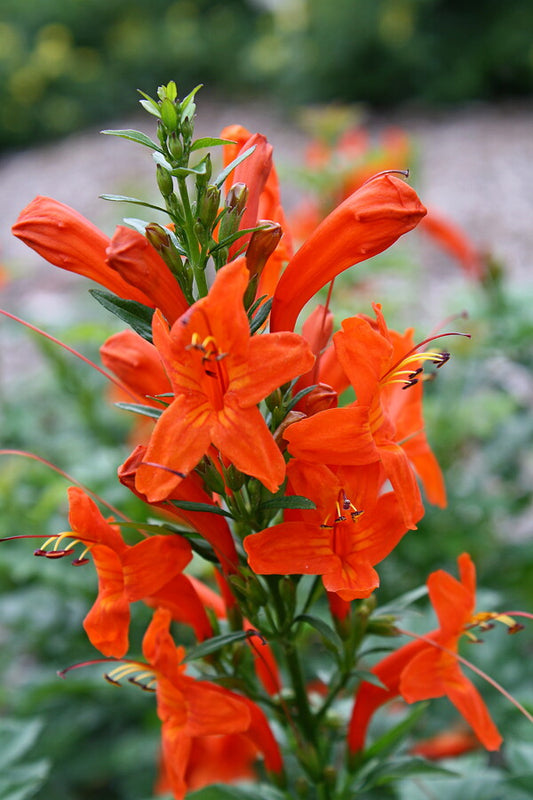The genus Tecomaria, commonly referred to as Trumpetbush, encompasses a group of flowering shrubs within the Bignoniaceae family. Originating from South Africa and other tropical regions of Africa and Asia, these plants have a storied history as ornamental favorites. Boasting eye-catching tubular flowers in shades of orange, red, and yellow, trumpetbushes entice pollinators like hummingbirds and butterflies, contributing to the ecosystem. With glossy dark green leaves, they present an appealing contrast to the blossoms. Adaptable and sturdy, trumpetbushes flourish in diverse conditions, ranging from garden beds to containers. Thriving in full sun to partial shade, they prefer well-draining soil and can tolerate drought once established.
-
Tecomaria capensis
Item #: 9341
Zones: 7b to 11
Dormancy: Winter
Height: 72" tall
Culture: Sun to Part Sun
Origin: South Africa
Pot Size: 3.5" pot (24 fl. oz/0.7 L)
Regular price $23.00Regular priceUnit price per
More Information About Tecomaria
The genus Tecomaria is a fascinating group of flowering shrubs that has captured the hearts of garden enthusiasts and landscapers around the world. With their vibrant blossoms, adaptability, and historical significance, Tecomaria species have become prized additions to gardens and landscapes, offering both aesthetic appeal and ecological value.
The story of the genus Tecomaria is one that spans continents and centuries. Native to regions such as South Africa, as well as tropical areas of Africa and Asia, these plants have a rich historical legacy. The name "Tecomaria" itself is derived from the municipality of Tecomán, Mexico, where certain species of these shrubs can also be found. Over time, Tecomaria species have traveled across the globe, finding homes in gardens and landscapes for their striking beauty and adaptability.
One of the most captivating aspects of Tecomaria is its stunning display of tubular flowers, often referred to as trumpetbush due to their shape. These flowers come in a range of captivating colors, including shades of orange, red, and yellow. The tubular shape not only adds an element of elegance to the plant but also serves a functional purpose by attracting pollinators such as hummingbirds and butterflies. The vibrant blooms against the backdrop of glossy, dark green leaves create a visually appealing contrast that draws attention and admiration.
Growing Conditions: Care and Maintenance of Your Tecomaria
Tecomaria species, including Tecoma and Trumpetbush, are known for their adaptability and relatively low-maintenance requirements. To ensure the successful growth of these plants, it's essential to provide the right growing conditions:
Sunlight: Tecomaria thrives in areas with full sun to partial shade. It's essential to select a planting location that receives adequate sunlight for healthy growth and prolific flowering.
Soil: Well-draining soil is key to preventing waterlogged roots. Tecomaria can tolerate various soil types but will perform best in soil that allows excess water to escape.
Watering: While Tecomaria is relatively drought-tolerant once established, regular watering is crucial during the initial stages of growth and flowering. Proper irrigation promotes robust growth and ensures a continuous display of flowers.
Pruning: Periodic pruning is recommended to maintain the shape and size of the plant. Prune after the flowering period to encourage new growth and enhance the overall appearance.
Landscape Tips: Incorporating Tecomaria into Your Design
Tecomaria species offer a multitude of options for enhancing your landscape design:
1.Focal Points: Use as focal points in your garden beds or along pathways. Their vibrant flowers and attractive foliage will naturally draw the eye and create visual interest.
2. Hedges and Screens: Plant closely to create beautiful hedges or privacy screens. Their dense growth habit and colorful blooms make them ideal for delineating spaces.
3. Container Gardening: Grow in containers to add a burst of color to patios, balconies, and other outdoor areas. Just ensure that the containers have proper drainage.
Companion Plants
When selecting companion plants to complement Tecomaria, consider options that enhance its beauty and contribute to the overall aesthetics of your landscape:
1. Lantana: Pair Tecomaria with lantana for a stunning display of complementary colors. Lantana's clusters of small, multicolored flowers perfectly accentuate Tecomaria's larger blooms.
2. Salvia: The upright spikes of salvia flowers provide an excellent contrast to the cascading form of Tecomaria. Their vibrant hues can create a visually striking combination.
3. Butterfly Bush: As the name suggests, butterfly bush or buddleia attracts butterflies and other pollinators, making it an ideal companion for Tecomaria. The two plants together create a haven for wildlife.
With their vibrant flowers, adaptability, and versatility in landscaping, tecomaria plants have become beloved additions to gardens worldwide. By understanding their growing conditions, landscape potential, and suitable companion plants, you can create stunning outdoor spaces that showcase the beauty and ecological value of Tecomaria species. Whether used as focal points, hedges, or container plants, tecomaria is a testament to nature's artistry and the gardener's creative touch.


